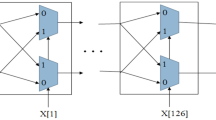Abstract
This paper presents a PUF (physical unclonable functions) authentication mechanism which can combat aging based on restrict race code (RRC). PUF provide a mechanism for identifying an integrated circuit based on the intrinsic variations of physical components uniquely and provide a cheap and secure alternative to random message storage on devices. However, due to its own characteristics, the chip-level PUF circuit reliability is easily affected by environment. The effect of reversible temporal noise on PUF is well studied and has obtained good effect (e.g. temperature, voltage), but sufficient attention has not been given so far to analyze the effect of the irreversible temporal variabilities (e.g. aging on PUF). This paper proposes a dynamic PUF authentication method, which is based on the RRC with two-ring strong characteristics structure. A combination of hardware and software system is used to improve the efficiency of authentication, and in an FPGA (field-programmable gate array)-based SRAM (static random access memory) PUF are used as an experimental object to verify the feasibility of this design. And this system can enhance the authentication system safety from the CVC (characteristic value challenge) randomness test.
创新点
现有的PUF(Physical unclonable functions)电路鲁棒性研究大都针对温度,电压,磁场等可逆噪声干扰,也取得了很好的应对效果。但是,对于电路老化这一不可逆噪声干扰却缺乏研究。本文完成了一种基于制约竞争码(RRC-Restrict Race Code)的PUF动态抗老化认证系统设计,通过使用软硬件结合的方式来提高认证效率,并以SRAM PUF为实验对象验证了该设计的可行性。而在接下来的工作中作者将着重于提高该系统的安全性。
Similar content being viewed by others
References
Lim D, Lee J W, Gassend B, et al. Extracting secret keys from integrated circuits. IEEE Trans VLSI Syst, 2005, 13: 1200–1205
Lee J W, Lim D, Gassend B, et al. A technique to build a secret key in integrated circuits for identification and authentication application. In: Proceedings of the Symposium on VLSI Circuits, Honolulu, 2004. 176–159
Yin C E D, Gang Q. Maximizing RO PUF’s secret extraction. In: Proceedings of IEEE Symposium on Hardware-Oriented Security and Trust, Anaheim, 2010. 100–105
Holcomb D E, Burleson W P, Fu K, et al. Initial SRAM state as a fingerprint and source of true random numbers for RFID tags. IEEE Trans Comput, 2007, 58: 11–13
Su Y, Holleman J, Otis B. A 1.6pj/bit 96% stable chip-ID generating circuit using process variations. In: Proceedings of IEEE International Solid-State Circuits Conference, San Francisco, 2007. 406–611
van der Leest V, Schrijen G J, Handschuh H, et al. Hardware intrinsic security from D flip-flops. In: Proceedings of the 5th ACM Workshop on Scalable Trusted Computing, New York, 2010. 53–62
Suzuki D, Shimizu K. The glitch puf: a new delay-puf architecture exploiting glitch shapes. In: Proceedings of Crypt-Ographic Hardware and Embedded Systems, Berlin, 2010. 366–382
Ravikanth P. Physical One-way Functions. Dissertation for the Doctoral Degree. Boston: Massachusetts Institute of Technology, 2001
Bulens P, Standaert F, Quisquater J J. How to strongly link data and its medium: the paper case. IET Inform Secur, 2010, 4: 125–136
Ghaith H, Aykutlu, Berk S. CDs have fingerprints too. In: Proceedings of the 11th International Workshop on Cryptographic Hardware and Embedded Systems, Berlin, 2009. 348–362
Maiti A, Schaumont P. The impact of aging on a physical unclonable function. IEEE Trans VL SI Syst, 2013, 99: 1854–1864
Meguerdichian S, Potkonjak M. Device aging-based physical unclonable functions. In: Proceedings of the 48th ACM/EDAC/IEEE Design Automation Conference, New York, 2011. 288–289
Kirkpatrick M S, Bertino E. Software techniques to combat drift in PUF-based authentication systems. In: Proceedings of Workshop on Secure Component and System Identification, Cologne, 2010
Author information
Authors and Affiliations
Corresponding author
Rights and permissions
About this article
Cite this article
Li, B., Chen, S. A dynamic PUF anti-aging authentication system based on restrict race code. Sci. China Inf. Sci. 59, 1–12 (2016). https://doi.org/10.1007/s11432-015-5287-9
Received:
Revised:
Accepted:
Published:
Issue Date:
DOI: https://doi.org/10.1007/s11432-015-5287-9




